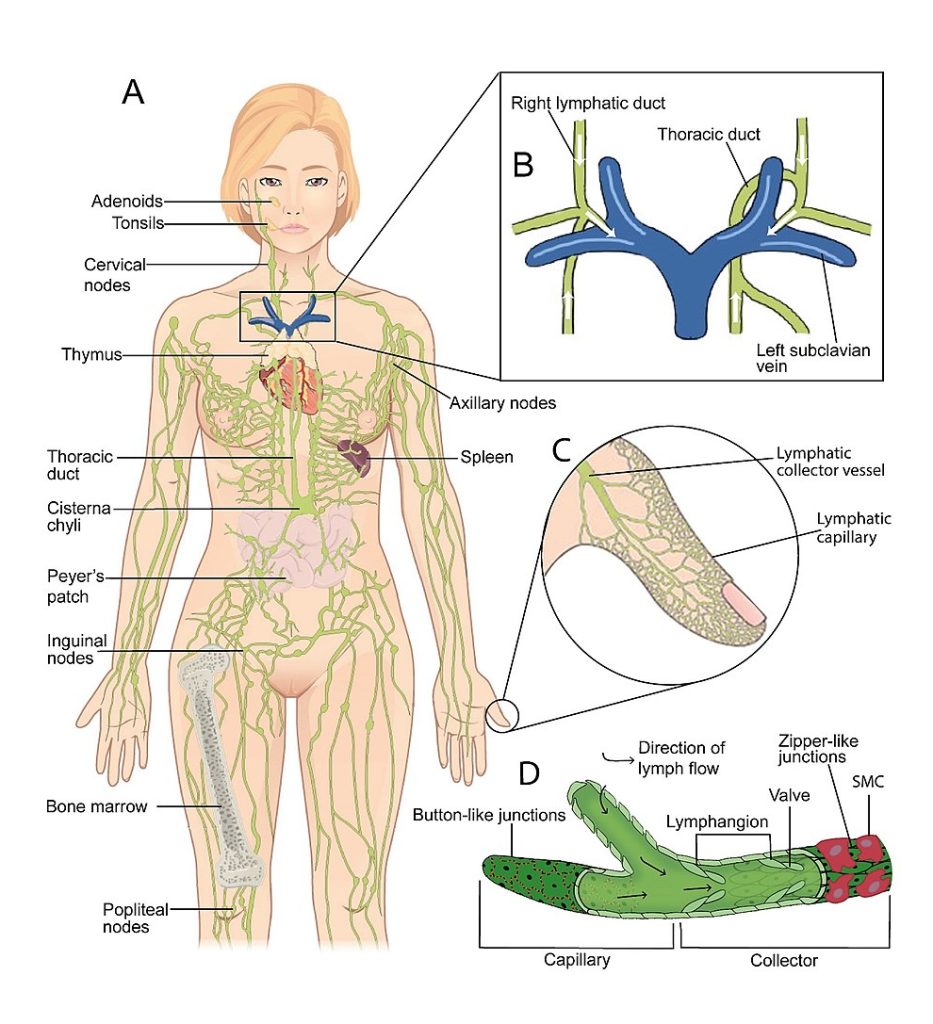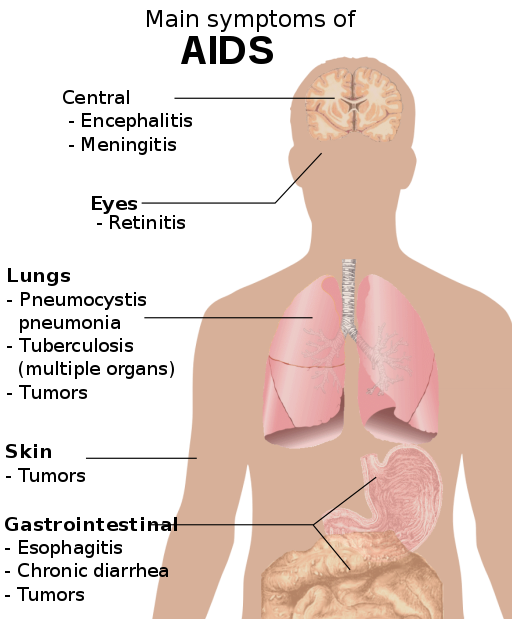6.7 Lymphatic System
Overview and Functions
The lymphatic system (Fig. 6.19) is one of the lesser-known systems of the human body, but it plays an extremely important function. It consists of a network of lymphatic vessels, lymph nodes, and ducts. One of the major functions of the lymphatic system is to drain body fluids and return them to the bloodstream. Blood pressure can cause leakage of fluid from the capillaries, resulting in the accumulation of fluid in the spaces between individual cells in the tissues. Each day, about 20 L of plasma flow through the body’s arteries, arterioles, and capillaries, but only about 17 L are returned to circulation by way of veins. The rest is released into the interstitial spaces of the tissues because of capillary filtration. The lymphatic system collects this excess fluid, now called lymph, from tissues in the body and returns it to the bloodstream.
The lymphatic system is also associated with the immune system to the point that the systems are virtually indistinguishable. The immune system is the complex collection of cells and organs that destroy and/or neutralize pathogens that could cause disease or death. Cells in the immune system use lymphatic vessels to make their way from the interstitial spaces back into the circulatory system, and they also use lymph nodes as staging areas for the development of immune responses. For example, lymph nodes swell during an infection, and lymphocytes are transported via the lymphatic vessels.

(CrashCourse, 2015)
Components of the Lymphatic System
Lymph: Lymph is the fluid contained within the lymphatic system.
Lymph nodes: These bean-shaped organs can be found throughout the body; some of those locations are shown in Fig. 6.19. Humans have 500 to 600 lymph nodes. Their function is to remove debris and pathogens from the lymph. Bacteria that infect interstitial fluid are taken up by the lymphatic capillaries and transported to a regional lymph node.
Lymphatic vessels: These vessels begin as capillaries, which feed into larger and larger lymphatic vessels, and eventually empty, through a series of ducts, into the bloodstream.
Lymphatic capillaries: These are the smallest of the lymphatic vessels and the start of the lymph flow. Interstitial fluid enters the lymphatic system via the capillaries to become lymph fluid. Lymphatic capillaries are located in almost every tissue in the body and are interwoven among the arterioles and venules of the circulatory system.
Lymphatic trunks: These are large lymphatic vessels that collect lymph from the smaller lymphatic vessels, such as the capillaries, and empty it into the blood via lymphatic ducts.
Lymphoid nodules: These nodules are non-encapsulated patches of lymphoid tissue and are found throughout the body. They are simpler than the lymph nodes and spleen in that they consist simply of a dense cluster of lymphocytes without a surrounding fibrous capsule. These nodules are located in the respiratory and digestive tracts, which are areas routinely exposed to environmental pathogens.
Lymphocytes: These are the primary cells of adaptive immune responses. The two basic types of lymphocytes are B cells and T cells, which are distinguished from one another by their surface protein markers, as well as by the molecules they secrete. Both types of cells initially develop in the bone marrow, but then the T cells move to the thymus to mature and the B cells remain in the bone marrow.
Bone marrow: Bone marrow is a primary lymphoid organ and is where B cells undergo nearly all of their development. It is also where immature T cells develop until they move to the thymus gland.
Spleen: The spleen is considered to be a major secondary lymphoid organ. It is about 12 cm (5 in) long and is a fragile organ without a strong capsule. The spleen is sometimes called the “filter of the blood” because of its extensive vascularization and the fact that it removes microbes and other materials from the blood.
Thymus: This primary lymphoid organ is found in the space between the sternum and the aorta of the heart. It is involved in the development and maturing of T cells and is most active during infancy and childhood.
Tonsils: These lymphoid nodules are located on the inner surface of the pharynx. They are important in fighting oral pathogens and developing immunity.
Combining Forms
Table 6.6. Combining Forms
| COMBINING FORM | MEANING | EXAMPLE OF USE IN MEDICAL TERMS |
|---|---|---|
| lymph/o | lymph fluid | lymphocyte |
| lymphaden/o | lymph node | lymphadenectomy |
| lymphangi/o | lymph vessel | lymphangitis |
| myel/o | bone marrow | myeloma |
| splen/o | spleen | splenectomy |
| thym/o | thymus gland | thymocyte |
| tonsill/o | tonsils | tonsillectomy |
Common Pathologies
Acquired immune deficiency syndrome (AIDS): This condition is caused by the human immunodeficiency virus (HIV) and was nearly 100% fatal when it first appeared. However, the development of antiviral medications has transformed HIV infection into a chronic, manageable disease. Signs and symptoms include malignancies, infections, lethargy, and gastrointestinal issues.

Autoimmune responses/diseases: When the immune system overreacts, individuals may experience autoimmune diseases. Often the cause is unknown, and treatment involves anti-inflammatory and immunosuppressive medications. Autoimmune diseases can be localized, like rheumatoid arthritis, or systemic, such as lupus (Carter & Rutherford, 2020).
Hodgkin’s lymphoma: This type of cancer affects the immune system and can cause antibodies to attack the nervous system. Masses of T and B lymphocytes collect in the spleen, liver, lymph nodes, and other tissues in the body. Theses lymphocytes do not work as they should, which makes it very likely the individual will develop infections.
Mononucleosis: This condition is an acute disease in which the lymph nodes become enlarged and the number of lymphocytes increases (Chabner, 2018). It is very contagious and was referred to in the past as the “kissing disease” because that is how many individuals were thought to have become infected with this illness.
Severe combined immunodeficiency disease (SCID): This is one of the most serious forms of inherited immunodeficiency diseases. It results in impaired B and T cells, which puts children at increased risk of infection. As a result, those that have this disease often die within the first year of life (Carter & Rutherford, 2020).
Exercise
Attribution
Unless otherwise indicated, material on this page has been adapted from the following resource:
Betts, J. G., Young, K. A., Wise, J. A., Johnson, E., Poe, B., Kruse, D. H., Korol, O., Johnson, J. E., Womble, M., & DeSaix, P. (2013). Anatomy and physiology. OpenStax. https://openstax.org/details/books/anatomy-and-physiology licensed under CC BY 4.0
References
Carter, K., & Rutherford, M. (2020). Building a medical terminology foundation. eCampus Ontario. https://ecampusontario.pressbooks.pub/medicalterminology/ licensed under CC BY 4.0
Chabner, D. E. (2018). Medical terminology: A short course (8th ed.). Saunders/Elsevier.
CrashCourse. (2015, November 30). Lymphatic system: Crash Course A&P #44 [Video]. YouTube. https://www.youtube.com/watch?v=I7orwMgTQ5I&list=PL8dPuuaLjXtOAKed_MxxWBNaPno5h3Zs8&index=45
Image Credits (images are listed in order of appearance)
Anatomy of the lymphatic system by SGUL lymres, CC BY-SA 4.0
Symptoms of AIDS by Mikael Häggström, Public domain
A type of white blood cell in the immune system; the main type of cell in lymph
Removal of a lymph node
Inflammation of the lymph vessels or lymphatic system
A malignant tumour in the bone marrow
Removal of the spleen
An immunity cell in the thymus gland
Removal of the tonsils

